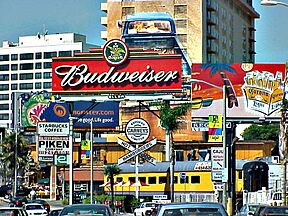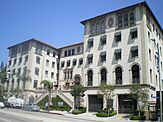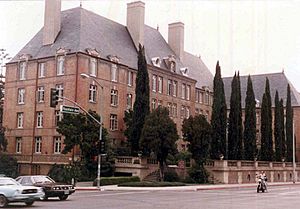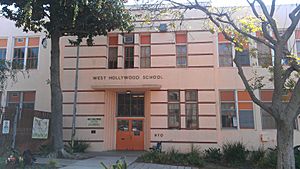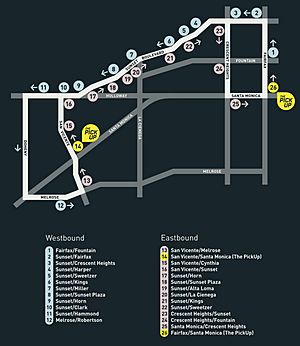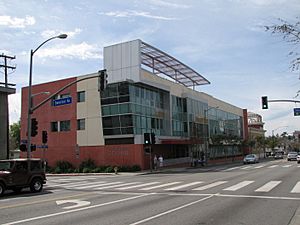West Hollywood, California facts for kids
Quick facts for kids
West Hollywood, California
|
|||
|---|---|---|---|
|
|
|||
|
|||
| Nickname(s):
WeHo
|
|||
| Motto(s):
"The Creative City"
|
|||
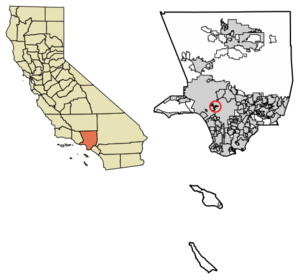
Location in Los Angeles County, California
|
|||
| Country | |||
| State | |||
| County | |||
| Incorporated | November 29, 1984 | ||
| Named for | Location west of Hollywood | ||
| Government | |||
| • Type | City Council/City Manager | ||
| Area | |||
| • City | 1.89 sq mi (4.89 km2) | ||
| • Land | 1.89 sq mi (4.89 km2) | ||
| • Water | 0.00 sq mi (0.00 km2) 0% | ||
| Elevation | 282 ft (86 m) | ||
| Population
(2020)
|
|||
| • City | 35,757 | ||
| • Density | 18,920/sq mi (7,312/km2) | ||
| Time zone | UTC−8 (Pacific) | ||
| • Summer (DST) | UTC−7 (PDT) | ||
| ZIP codes |
90038, 90046, 90048, 90069
|
||
| Area codes | 310/424, 213/323 | ||
| FIPS code | 06-84410 | ||
| GNIS feature IDs | 1652810, 2412221 | ||
West Hollywood is a city in Los Angeles County, California. It became a city in 1984 and is famous for its Sunset Strip. In 2020, about 35,757 people lived there.
Contents
- Discovering West Hollywood's Past
- Exploring West Hollywood's Location
- People of West Hollywood
- West Hollywood's Economy
- Arts and Culture in West Hollywood
- Education in West Hollywood
- City Services and Transportation
- Famous People and Places
- Landmarks and Special Spots
- West Hollywood's Unique Laws
- See also
Discovering West Hollywood's Past
Most stories about West Hollywood's history start in the late 1700s. This is when European explorers arrived. A Portuguese explorer named João Rodrigues Cabrilho claimed the area for Spain.
About 5,000 native people from the Tongva tribe greeted his ship. The Tongva were hunter-gatherers. They were known for their love of dance. By 1771, many Tongva people had become sick. This was due to diseases brought by the Europeans.
The Spanish later renamed the Tongva tribe "Gabrielinos." This name came from the Mission San Gabriel Arcángel. In the 1770s, a Mexican expedition stopped near what is now West Hollywood. They collected sticky tar from tar pits. This tar was used to waterproof their belongings. The Gabrielinos likely burned the tar for fuel.
By 1780, the "Sunset Strip" area was a main road. It connected El Pueblo de Los Angeles to ranches near the Pacific Ocean. Over the next 100 years, this land had different owners. It was known by names like "La Brea" and "Plummer." Most of it was part of the Rancho La Brea. Eventually, the Henry Hancock family owned it.
The Town of Sherman
In the late 1800s, the town of "Sherman" grew quickly. This town was founded by Moses Sherman and his partners. They ran the Los Angeles Pacific Railroad. This railroad later became part of the Pacific Electric Railway.
Sherman became a hub for the railroad. It had main shops, train yards, and car barns. Many railroad workers lived in Sherman. The area became known for being a bit wild. It had fewer rules, especially during Prohibition. People who didn't like too much government control moved there. Even though Los Angeles tried to add Sherman to its city, the town chose to stay separate.
For many years, West Hollywood was an area outside of Los Angeles city limits. Because some activities were not allowed in Los Angeles, but were allowed in the county, many fun places opened along Sunset Boulevard. These businesses were not under the strict rules of the L.A. Police Department.
People involved in movie-making liked this freer area. Many unique apartment buildings and hotels were built. Interior designers and furniture showrooms also set up shop here.
Later, the big nightclubs became less popular. But the Sunset Strip still attracted visitors. In the late 1960s, the hippie movement changed the Sunset Strip again. It became a center for music and hippie culture. Young people from all over the country came to West Hollywood.
Becoming a City
After the dissolution of the Soviet Union, many Russian Jews moved to West Hollywood. Thousands arrived in two main waves. West Hollywood now has one of the largest Russian-speaking communities in the United States, outside of New York.
In 1984, West Hollywood officially became its own city. This happened because of a group effort. People were worried about losing their homes due to changes in housing rules. So, a group of people, including older residents and Russian immigrants, voted to form a city. They elected a city council that quickly passed strong laws to protect renters.
Exploring West Hollywood's Location
West Hollywood is next to Beverly Hills on the west. To the north are the Hollywood Hills. To the east is Hollywood. The Fairfax District is to the southeast. Beverly Grove is to the southwest.
The city's shape is a bit unusual. This is because it was formed from parts of Los Angeles County that were not yet part of other cities.
West Hollywood is a very compact city. It has small areas, different types of buildings, and streets that are easy to walk. It is known as the most walkable city in California. This means you can easily walk to many places.
Popular areas include the Sunset Strip for nightlife and dining. Santa Monica Boulevard also has many businesses. The Avenues of Art and Design are along Robertson, Melrose, and Beverly Boulevard.
Residential areas are small, only a few blocks long. These include Norma Triangle and West Hollywood West. Major streets usually have shops and services nearby.
West Hollywood's Climate
West Hollywood has a warm climate all year. It's a mix of subtropical and semi-arid climate. Winter nights can be cool. The highest temperature ever recorded was 111°F (44°C) in 1963. The lowest was 24°F (-4°C) in 1949.
It doesn't rain much, only about 13 inches a year. Most rain falls in winter. Snow is very rare. The last time it snowed was in 1949.
| Climate data for West Hollywood, California | |||||||||||||
|---|---|---|---|---|---|---|---|---|---|---|---|---|---|
| Month | Jan | Feb | Mar | Apr | May | Jun | Jul | Aug | Sep | Oct | Nov | Dec | Year |
| Record high °F (°C) | 90 (32) |
92 (33) |
91 (33) |
105 (41) |
101 (38) |
107 (42) |
102 (39) |
103 (39) |
111 (44) |
106 (41) |
100 (38) |
91 (33) |
111 (44) |
| Mean daily maximum °F (°C) | 67 (19) |
69 (21) |
69 (21) |
73 (23) |
73 (23) |
77 (25) |
80 (27) |
81 (27) |
80 (27) |
77 (25) |
72 (22) |
68 (20) |
74 (23) |
| Mean daily minimum °F (°C) | 46 (8) |
47 (8) |
49 (9) |
52 (11) |
56 (13) |
59 (15) |
62 (17) |
62 (17) |
61 (16) |
57 (14) |
51 (11) |
46 (8) |
54 (12) |
| Record low °F (°C) | 24 (−4) |
31 (−1) |
32 (0) |
32 (0) |
32 (0) |
43 (6) |
47 (8) |
49 (9) |
45 (7) |
40 (4) |
33 (1) |
30 (−1) |
24 (−4) |
| Average precipitation inches (mm) | 3.19 (81) |
3.05 (77) |
2.66 (68) |
0.58 (15) |
0.26 (6.6) |
0.04 (1.0) |
0.02 (0.51) |
0.07 (1.8) |
0.08 (2.0) |
0.33 (8.4) |
0.94 (24) |
1.90 (48) |
13.12 (333) |
People of West Hollywood
| Historical population | |||
|---|---|---|---|
| Census | Pop. | %± | |
| 1960 | 28,870 | — | |
| 1970 | 34,622 | 19.9% | |
| 1980 | 35,703 | 3.1% | |
| 1990 | 36,118 | 1.2% | |
| 2000 | 35,716 | −1.1% | |
| 2010 | 34,399 | −3.7% | |
| 2020 | 35,757 | 3.9% | |
| U.S. Decennial Census | |||
In 2020, West Hollywood had 35,757 residents. The city is very densely populated. This means many people live in a small area.
West Hollywood is known for its diverse community. Many different groups of people live here. The city has a large population of people who identify as lesbian, gay, bisexual, or transgender (LGBT). This makes West Hollywood a popular place for LGBT travelers. It has many fun places like spas, shops, and restaurants.
The city keeps many historical records about the LGBT community. The West Hollywood Library has a large collection of LGBT books and history. This includes the June L. Mazer Lesbian Archives. The ONE Archives Gallery and Museum is the first museum in Southern California focused on gay history. In 2018, West Hollywood held America's first city-wide Bi Pride event.
West Hollywood's Economy
West Hollywood has many businesses. Here are some of the top employers in the city, based on a 2021 report:
| No. | Employer | No. of employees |
|---|---|---|
| 1 | Los Angeles County Metropolitan Transportation Authority | 559 |
| 2 | Target | 289 |
| 3 | CityGrid Media / InterActive Corp | 288 |
| 4 | City of West Hollywood | 240 |
| 5 | 1 OAK | 200 |
| 6 | Laz Parking | 200 |
| 7 | Pavilions | 180 |
| 8 | Argyle Hotel | 165 |
| 9 | Andaz West Hollywood | 161 |
| 10 | Whole Foods Market | 153 |
Arts and Culture in West Hollywood
West Hollywood is a lively place with many events and cultural activities.
Fun Festivals and Events
- West Hollywood Halloween Carnaval: This is a huge Halloween street party every October 31. It stretches over a mile of Santa Monica Boulevard. Up to 500,000 people attend each year.
- Christopher Street West: This is an LGBT pride parade and festival. It started in 1970 in Hollywood. After West Hollywood became a city, the event moved here for many years. It celebrates LGBT pride.
- WeHo Pride Arts Festival: This festival celebrates LGBTQ+ arts. It used to last 40 days. In 2024, it will be a special weekend of events from June 14 to June 16.
- Rainbow Key Awards: Since 1993, the city has given these awards. They honor people who have done great things for West Hollywood's LGBTQ+ community.
- West Hollywood Book Fair: This event has been held every fall since 2001. Famous authors like Deepak Chopra have participated.
- The Oscars Parties: Many big parties for the Academy Awards (the Oscars) happen in West Hollywood. Streets are often closed, and traffic gets busy on this day.
- Frontrunners LGBT Pride Run: This is a 5k/10k run or walk. It takes place on the Sunday morning of LGBT Pride.
- Pet Appreciation Days: The city holds events for pets and their owners. These sometimes include pet psychics and dog activities. During Halloween, there's a pet costume contest in West Hollywood Park.
- Elton John AIDS Foundation Party: This big event raises millions of dollars for the Elton John AIDS Foundation. It usually happens at the Pacific Design Center.
Art and Literary Programs
West Hollywood has many ongoing programs to celebrate its arts and culture.
- WeHo Reads: This is a year-round series for book lovers. It features new authors at the West Hollywood Library. There is also a full-day literary event each fall.
- PowPow: This event is presented by AIDS Project Los Angeles Red Circle Project. It promotes awareness about HIV among Native communities. It features dance, music, food, and educational resources.
- City Poet: In 2014, Steven Reigns became West Hollywood's first City Poet.
- Drag Laureate: In 2023, Pickle Drag Queen became West Hollywood's first drag laureate.
Education in West Hollywood
Schools for Kids
All schools in West Hollywood are part of the Los Angeles Unified School District.
Here are some elementary schools that serve different parts of West Hollywood:
- West Hollywood Elementary School (Kindergarten to 6th grade)
- Rosewood Avenue Elementary School (Kindergarten to 5th grade)
- Laurel Elementary School (Kindergarten to 8th grade)
- Melrose Elementary School (Kindergarten to 6th grade)
- Gardner Street Elementary School (Kindergarten to 5th grade)
Most middle school students go to Bancroft Middle School. Some students in the south go to John Burroughs Middle School.
For high school, most students attend Fairfax High School. Some areas are also zoned for Hollywood High School.
There are also private schools in West Hollywood:
- West Hollywood College Preparatory School (WHCP) (Kindergarten to 12th grade)
- The Center for Early Education
- Pacific Hills School
City Services and Transportation
West Hollywood works to make life better for its residents.
Getting Around West Hollywood
Traffic and parking can be tricky in West Hollywood. This is because it's located between busy areas like Hollywood and the San Fernando Valley. The Hollywood Hills also make it harder to get around to the north.
Santa Monica Boulevard and Sunset Boulevard are important roads for travel. Laurel Canyon Boulevard is a popular shortcut through the hills. The city is also planning for a new train line, the K Line, which might pass through or near West Hollywood.
The PickUp Shuttle
In 2013, West Hollywood started a free shuttle service called The PickUp. It runs on Friday and Saturday nights. It connects the eastern and western parts of the city. The goal is to offer a fun way to get around without a car. This is especially helpful in busy nightlife areas.
The Sunset Trip Shuttle
In 2018, another free shuttle started called The Sunset Trip. This shuttle focuses on Sunset Boulevard. It also connects with The PickUp shuttle, so you can switch between them.
Community Support Services
West Hollywood offers many services to help its residents.
The city supports programs for people living with HIV or AIDS. For example, Project Angel Food gets city funding to deliver healthy meals daily. AIDS Project Los Angeles (APLA) helps people understand public benefits. APLA also provides free dental, therapy, and medicine services. Aid for AIDS helps with rent and other expenses. The city also helps agencies that train people to return to work.
West Hollywood also helps its growing number of children. The "Healthy Start West Hollywood" program teaches kids about good nutrition. This includes activities like vegetable gardens and yoga.
Programs also help senior citizens. West Hollywood supports adult day care, a roommate matching service, and healthy meals. The West Hollywood Senior Center offers fun activities, trips, and counseling.
The city also helps residents who don't have good health insurance. It supports the LA Free Clinic and The Los Angeles Gay and Lesbian Center. Residents can get free medical, dental, legal, and mental health services at these places.
West Hollywood Library

The County of Los Angeles Public Library runs the West Hollywood Library. It is located at 625 North San Vicente Boulevard.
The current library building opened in 2011. It was designed by architects Steve Johnson and James Favaro. The outside of the library and parking garage have murals by famous artists like Shepard Fairey and Kenny Scharf. The inside also has special designs.
Famous People and Places
West Hollywood is home to many famous people. The city often discusses how to manage Paparazzi (photographers who follow celebrities). The area is close to the "Thirty Mile Zone," which is a common area for filming.
Actress Drew Barrymore lived in West Hollywood when she was young. She moved back to the city when she was 14.
Mayors of West Hollywood
- Valerie Terrigno (1984–1985)
- John Heilman (1985–1986)
- Stephen Shulte (1986–1987)
- Alan Viterbi (1987–1988)
- Helen Albert (1988–1989)
- Abbe Land (1989–1990)
- John Heilman (1990–1991)
- Paul Koretz (1991–1992)
- Babette Lang (1992–1993)
- Sal Guarriello (1993–1994)
- Abbe Land (1994–1995)
- John Heilman (1995–1996)
- Paul Koretz (1996–1997)
- Sal Guarriello (1997–1998)
- Steve Martin (1998–1999)
- John Heilman (1999–2000)
- Jeff Prang (2000–2001)
- John Heilman (2001–2002)
- Sal Guarriello (2002–2003)
- Jeff Prang (2003–2004)
- John Duran (2004–2005)
- Abbe Land (2005–2006)
- John Heilman (2006–2007)
- John Duran (2007–2008)
- Jeff Prang (2008–2009)
- Abbe Land (2009–2010)
- John Heilman (2010–2011)
- John Duran (2011–2012)
- Jeff Prang (2012–2013)
- Abbe Land (2013–2014)
- John D'Amico (2014–2015)
- Lindsey P. Horvath (2015–2016)
- Lauren Meister (2016–2017)
- John Heilman (2017–2018)
- John Duran (2018–2019)
- John D'Amico (2019–2020)
- Lindsey P. Horvath (2020–2021)
- Lauren Meister (2021–2023)
- Sepi Shyne (2023–2024)
- John M. Erickson (2024–Present)
Landmarks and Special Spots
West Hollywood has many unique and famous places.
Alta Loma Road is home to the Sunset Marquis Hotel. This hotel has the Whisky Bar and NightBird Recording Studios. These studios are where music is produced.
The western part of Melrose Avenue is known for trendy clothing stores. It also has interior design shops, restaurants, and antique stores. The end of Melrose Avenue near the Pacific Design Center is famous for its fancy furniture.
The area around Fountain Avenue, Harper Avenue, and Havenhurst Drive has many old apartment buildings. These buildings were built in the 1920s in Spanish Revival and Art Deco styles. Many famous people have lived in this historic area. For example, the Sunset Tower was once home to Frank Sinatra and John Wayne.
Some notable businesses and attractions in West Hollywood include:
- The Sunset Strip
- Hotels like Andaz West Hollywood and the Mondrian
- The Pacific Design Center
- Famous architecture like The Schindler House
- Music venues such as Whisky a Go Go, The Troubadour, and The Roxy Theatre
- Westlake Recording Studios, where Michael Jackson recorded his albums Thriller and Bad
- Popular hangouts like Formosa Cafe, Rainbow Bar and Grill, and The Abbey Food & Bar
- Film and TV studios like Samuel Goldwyn Studio (now The Lot)
- Parks, including historic Plummer Park
- Comedy Store
- Sierra Towers, a tall residential building
- Saint Victor Catholic Church
- West Hollywood Gateway Project, a large shopping center with public art
- Bodhi Tree Bookstore, a well-known independent bookstore
West Hollywood's Unique Laws
West Hollywood has passed many special laws.
In 1985, West Hollywood was the first city to allow same-gender domestic partnership registration. It also offered benefits for city employees in same-gender partnerships.
The city has laws about affordable housing. Developers must either provide affordable homes in new projects or pay a fee. This fee helps fund other affordable housing projects.
West Hollywood was one of the first cities to require green building practices in 2007.
The city has a law that calls pets "companions" and their owners "guardians." It was also the first city in the U.S. to ban the de-clawing of cats. In 2011, West Hollywood became the first U.S. city to ban the sale of real animal fur clothing. This ban started in 2013.
Other city laws include banning the sale of handguns. Smoking is also not allowed in public places. The city also avoids doing business with countries that violate human rights. Gas-powered leaf blowers are also banned.
As of July 2023, West Hollywood has the highest minimum wage in the country. It is $19.08 per hour.
See also
 In Spanish: West Hollywood para niños
In Spanish: West Hollywood para niños


